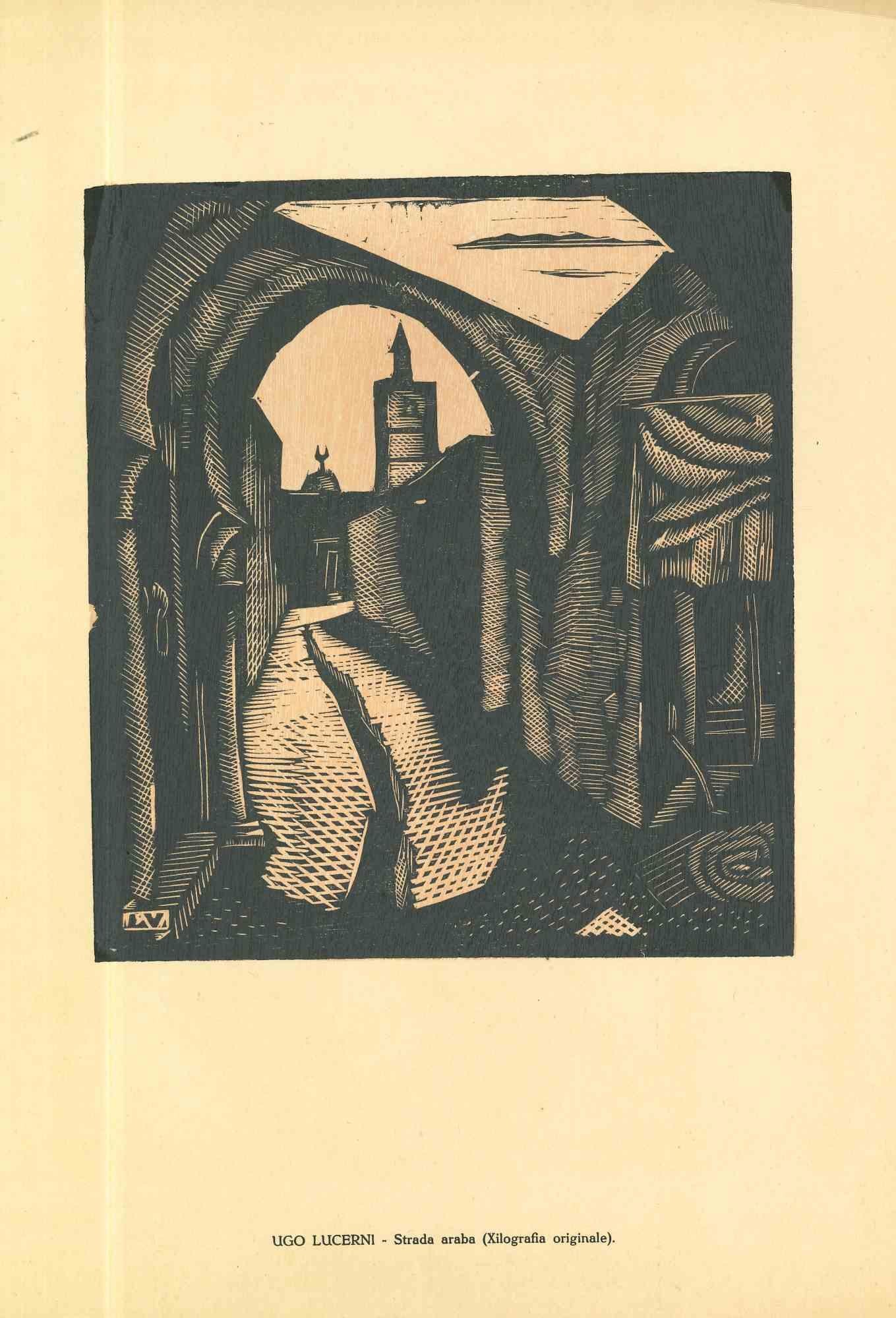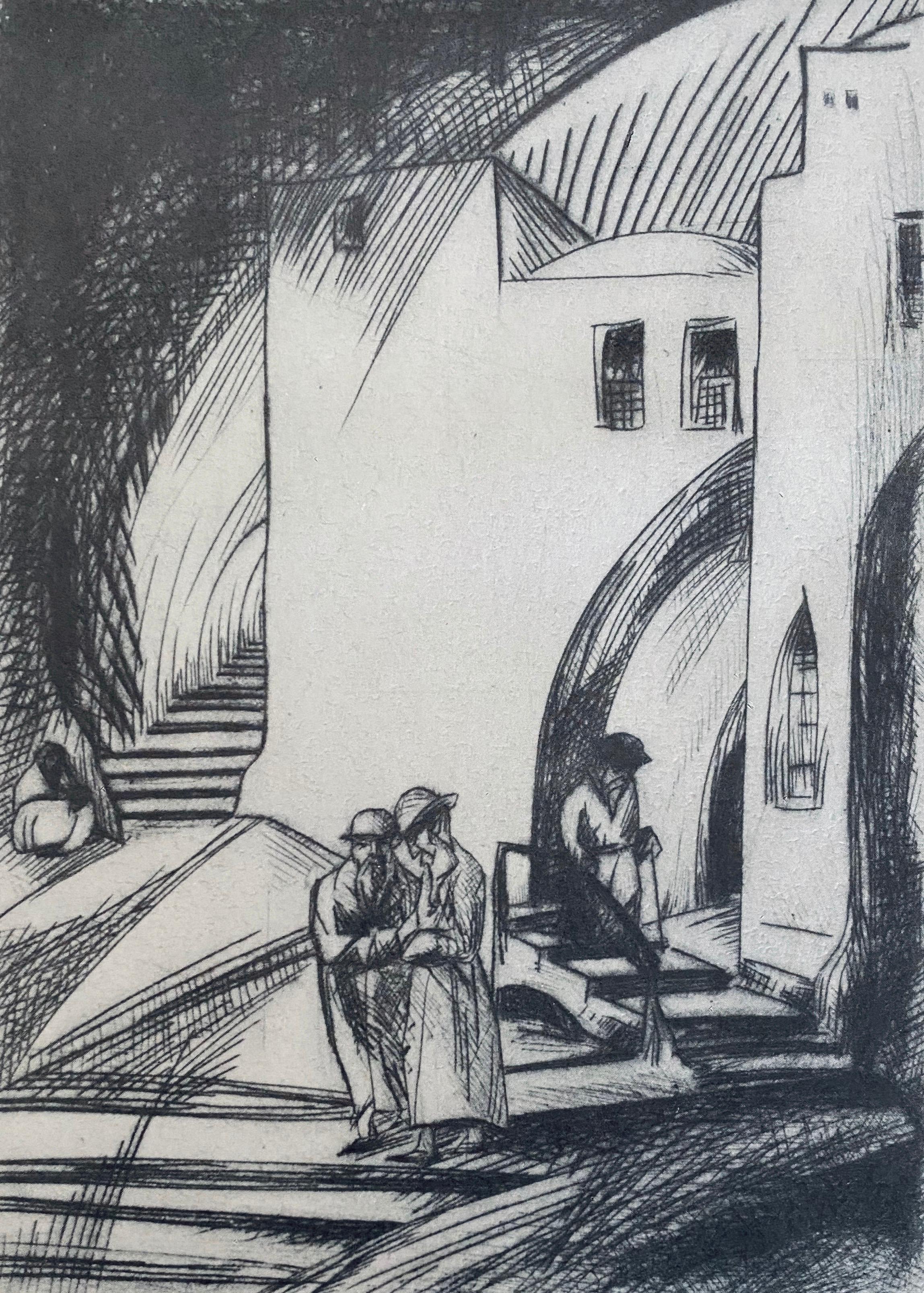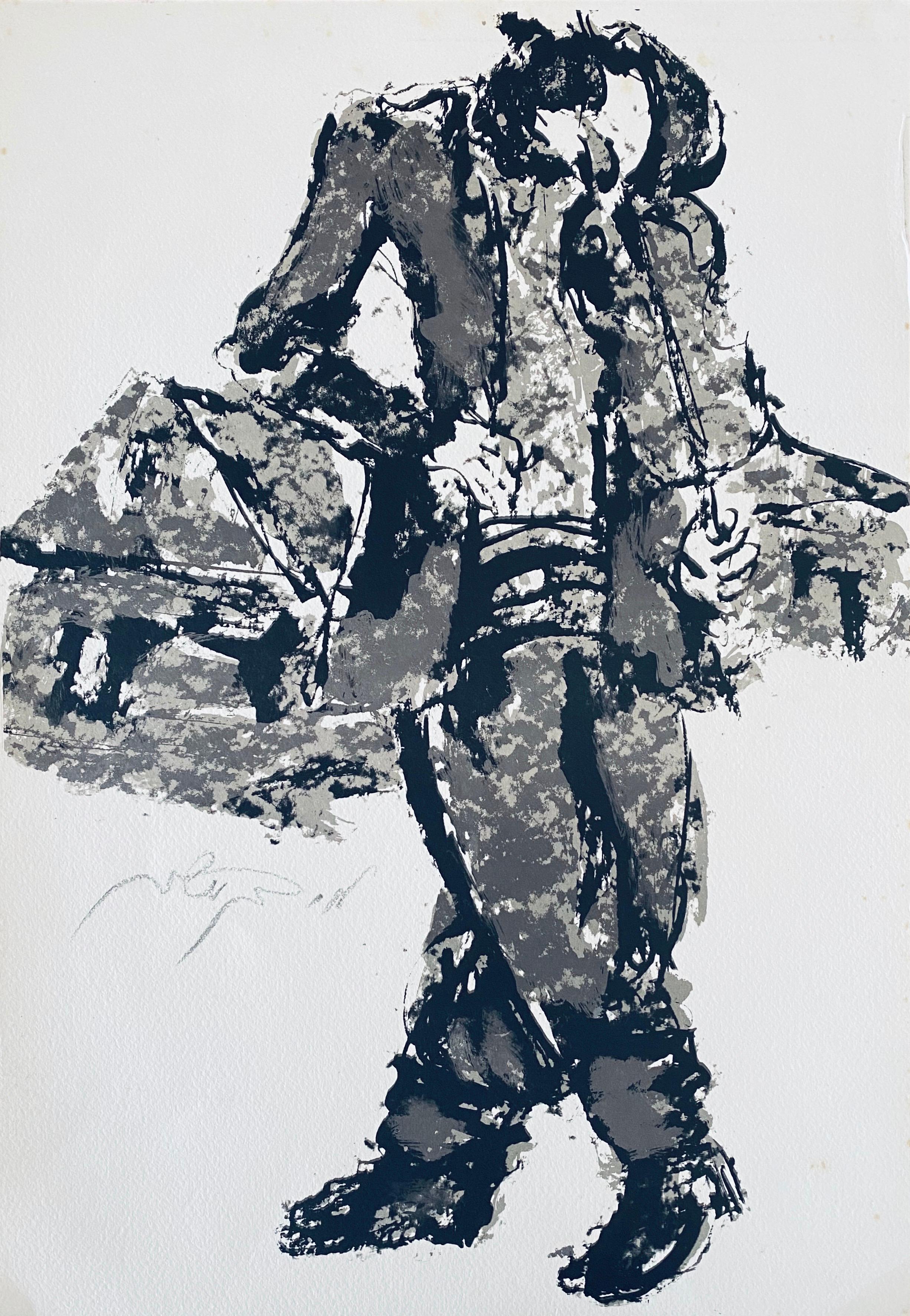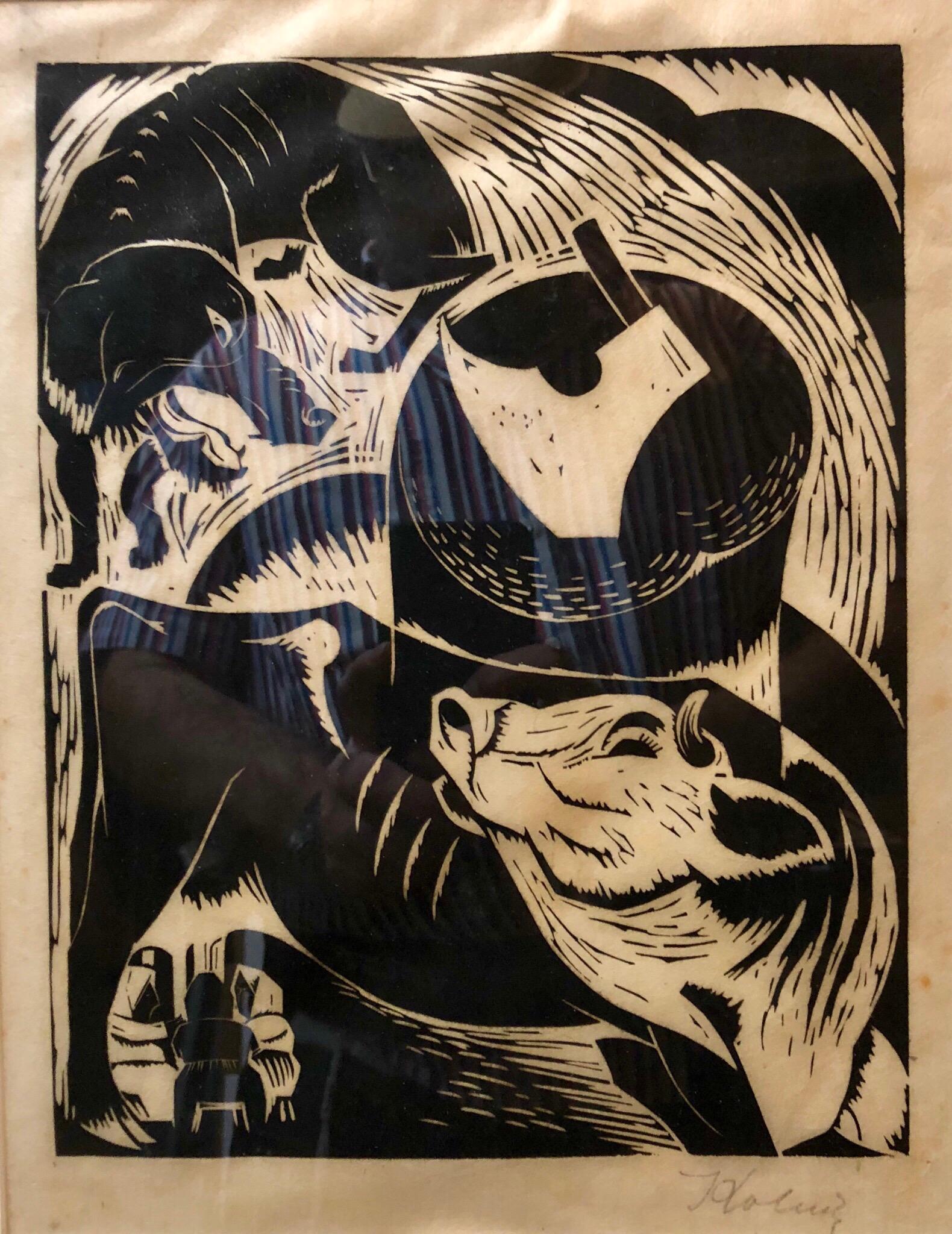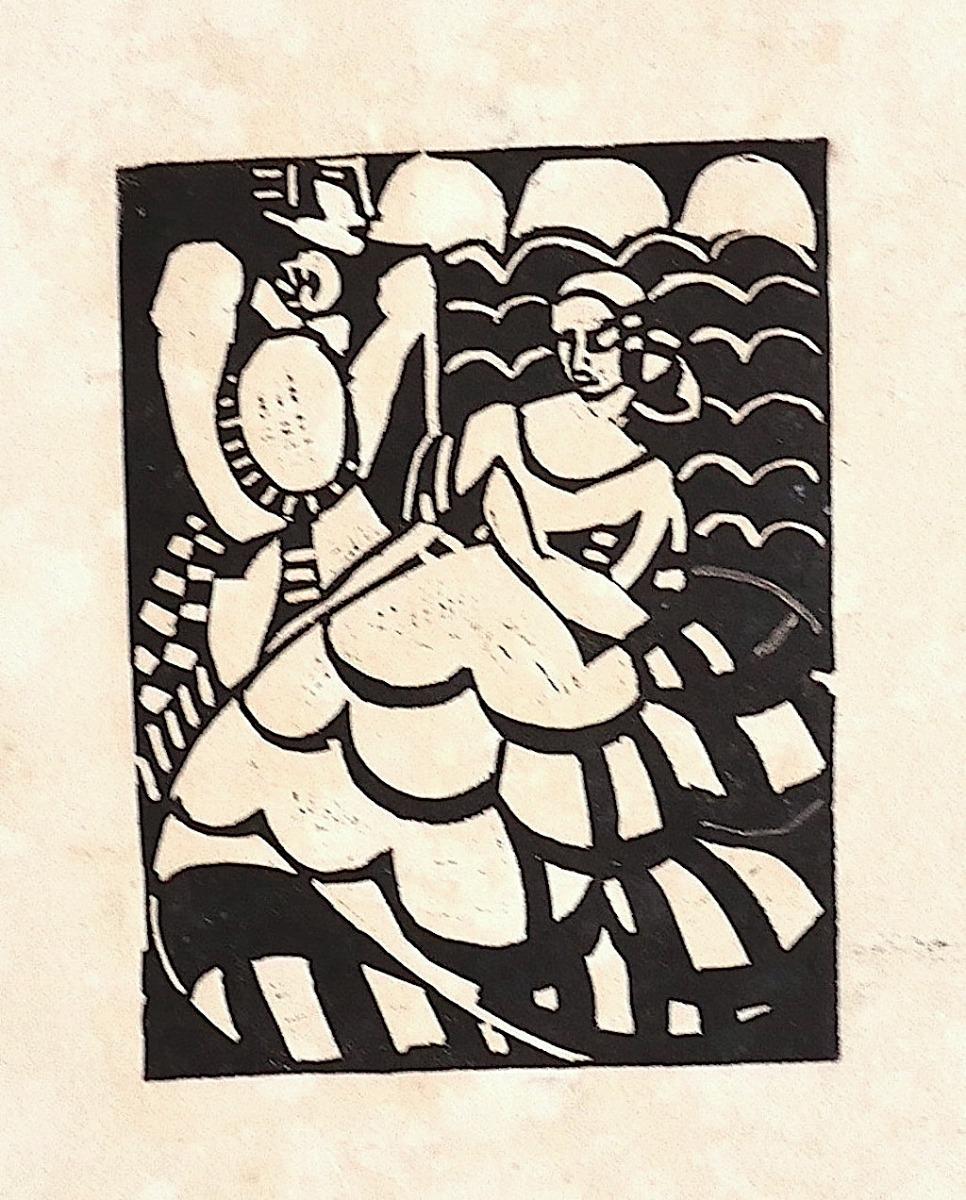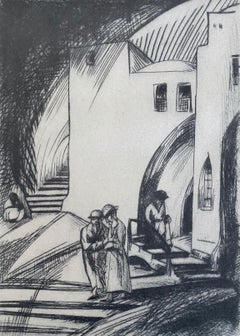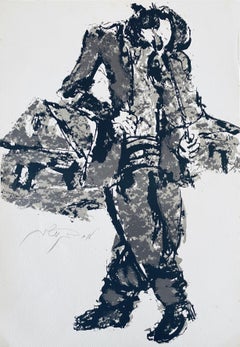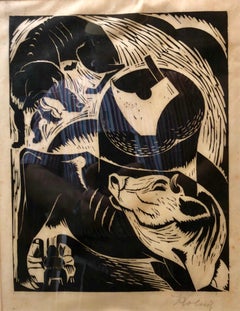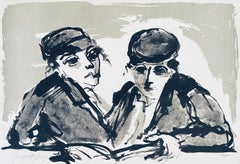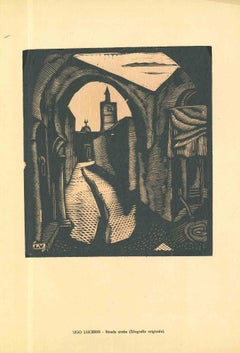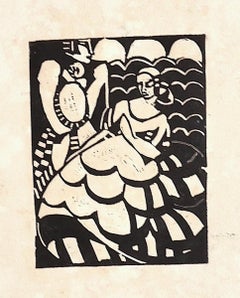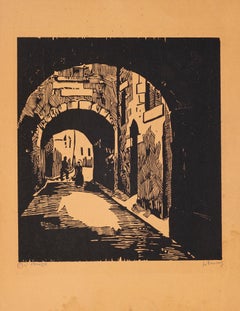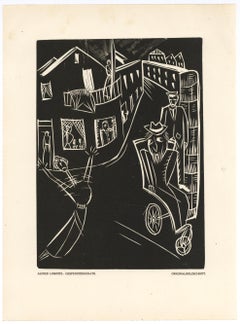Items Similar to Woodblock Print Polish Israeli Artist Azriel Awret Rainy Street Jerusalem Israel
Want more images or videos?
Request additional images or videos from the seller
1 of 12
Irene AwretWoodblock Print Polish Israeli Artist Azriel Awret Rainy Street Jerusalem Israel
$450
£343.57
€397
CA$631.71
A$704.11
CHF 369.42
MX$8,598.36
NOK 4,677.70
SEK 4,421.14
DKK 2,962.95
About the Item
Awret, Azriel (Polish Israeli, 1910-2010),
Rainy Street in Jerusalem,
Woodblock print, 9.75 x 7.5 inches, pencil hand signed and numbered 35/60, framed measuring 19.5 x 14.25 inches.
Azriel Awret was born in Lodz, Poland, and moved to Belgium where he lived in Brussels. He married an Aryan woman, Anna Louisa Bonhiere, which saved him from deportation. But in January 1943 he was interned in Malines camp. Awret was an engineer, so he was given employment as an electrician. While in Malines he met Irène Spicker, who was working in the Mahlerstube (art workshop). They married after the war and moved to Israel, settling in Safed and continuing their artistic activity. Today they divide their time between Israel and the United States.
The Beit Lohamei Haghetaot (The Ghetto Fighters’ House Museum) art collection includes works by Awret from his time in Malines. These works depict various aspects of life in Malines, including figures of internees. They were donated by the artist.
He collaborated with his wife in a naif, folk art style.
Irène Awret was born to a Jewish family in Berlin called Spicker, the youngest of three children. Her mother died in 1927, when Irène was six years old. In 1937 she was forced to stop high school, due to the Nazi race laws. Because she could not continue her regular studies, her father sent her to study drawing, painting and art restoration with a Jewish painter. Among his students were a large number of German Jews who knew they would have to leave Germany within a short time and would require a profession to enable them to support themselves.
When the situation grew worse, following the Kristallnacht (the first major attack on German and Austrian Jews in November 1938), her uncle decided to move to Belgium. In 1939 the situation became even worse - her father was fired from his job and the family were forced to leave their home. As a result, Awret's father tried to send her and her sister to Belgium, with the help of smugglers. The first smuggler proved to be a double agent and they were sent back from Aachen to Berlin. Two weeks later they made a second, successful, attempt to sneak across the border.
Awret worked for a Dutch Jewish family as a maid. As she had her room and board there, she was able to save enough money to study art part-time at Brussels' Académie Royal des Beaux-Arts. A few months later Awret's father joined her and her financial situation became easier. She left her job and studied full-time, helping support herself with restoration work when it was available and by painting portraits to order.
Later, Awret found a hiding place on a farm in Waterloo with a Jewish family who were connected with the underground. In January 1943 she had to return to Brussels, living with a false identity card which stated she was a married woman with two children. Awret succeeded in renting an attic without informing the police where she was - she told her landlady that she had been forced to flee her husband because he beat her. While there, she supported herself by restoring wooden sculptures.
A Jewish informer gave her up to the Gestapo, accompanying the two Gestapo men who arrested her. Awret was able to take a bag containing food and drawing materials. She was detained in the Gestapo cellars in Brussels where she drew. Because there was nothing there to draw, she sketched her own hand (view this work). Awret was interrogated in order to reveal the hiding place of her father who was still in Brussels. The National Socialist regime was determined to persecute him, even though he had fought for Germany in World War I and been permanently disabled. They stepped up their torture and brought Awret before Hartmann, the head of the Gestapo in Brussels. When Hartmann saw her block of drawings, he asked her where she had studied art and halted the interrogation.
Awret was placed in a narrow cell and then transferred to Malines camp, which the Belgian's called Mechelen. Malines was a transit camp to Auschwitz, regularly sending 2000 people at a time. Although she arrived just before Transport No. 20, Irène Awret avoided being included. Instead she was put to work in the leather workshop, decorating broaches. While she was there, Hartmann visited the camp and spotted her: "I could have discovered where your father is hiding," he told her. When her artistic talents became known, she was transferred to the Mahlerstube (artist's workshop) where she worked producing graphics for the Germans until the end of the war. When Carol (Karel) Deutsch (whose works are now on view at Yad Vashem) was sent from Mechelen to his death with his wife, he left young Irene his paintbox. Irene also recalls seeing the great painter Felix Nussbaum and his wife being pushed into a boxcar bound for the gas, and tells of the aftermath of the famous 20th Train incident, when a young Jewish doctor armed only with a pistol and helped by two unarmed friends with a lantern ambushed one of Mechelen's Auschwitz-bound trains carrying 1,618 Jews, most of whom had fled Eastern Europe for Belgium.
Awret's job enabled her to paint and draw - mainly in pencil, but also in watercolors and oils. In the artists' workshop she met a Jewish refugee from Poland - Azriel Awret - who would later become her husband. Among the other artists in the workshop were Herbert von Ledermann-Vütemberg, a sculptor from an aristocratic family with Jewish roots, Léon Landau, and Smilowitz, who perished in the camps in the East. Irène and Azriel tried to bribe a German officer to prevent Smilowitz's deportation. Not only were they unsuccessful, but they were almost put onto the same train. Jacques Ochs was another artist with whom they became friends in the camp. Ochs, a French-born Protestant who lived in Belgium, was interned as a political prisoner. He remained in Belgium after liberation.
After the war the Awrets immigrated to Israel and made their home in Safed. They continued to work, and were instrumental in founding Safed's artists' quarter.
The Beit Lohamei Haghetaot (Ghetto Fighters' House Museum) art collection holds works donated by Awret. These date from her time in Malines camp and from her stay in Brussels after the war, when she was in the company of orphans who had hidden while their parents were sent to Auschwitz. Her highly expressive works have made their way to exhibitions at theTel Aviv Museum, the Haifa Museum of Modern Art and the Modern Art Gallery in Washington, D.C., as well as into the private collections of such individuals as Dr. Jonas Salk, Charlie Chaplin and Joan Fontaine. She wrote an autobiography "They Will Have to Catch Me First." detailing her life during the Holocaust and how art saved her.
Israel has had a Vibrant Folk Art, Naive art scene for a long time now beginning with the Bezalel school, artists like Israel Paldi, Nahum Guttman, Reuven Rubin had naive periods. The most well know of the strict naive artists are Shalom of Safed, David Sharir, Irene Awret, Gabriel Cohen, Natan Heber, Michael Falk and Kopel Gurwin.
He was included in the General Exhibition, Art in Israel Tel Aviv Museum of Art, 1954
Artists: Mordechai Avnieli, Arieh Allweil, Aharon Avni, Naftali Bezem, Ludwig Blum, Yosl Bergner, Genia Berger, Marcel Janco, Moshe Mokady, Esther Peretz Arad, Ruth Schloss, Bezalel Schatz, Awret Azriel,
Tel Aviv Museum, Dizengoff House, Tel Aviv, 1959
Artists: Awret, Irene, Ann Medalie, Israel Paldi, Pinchas Shaar.
General Exhibition, On the Occasion of the 50th Anniversary of the City of Tel-Aviv Tel Aviv Museum of Art, Tel Aviv 1959
Artists: Shraga Weil, Shmuel Katz, Zvi Mairovich, Ori Reisman, Avraham Binder.
General Exhibition of Art in Israel 1963 General Exhibition of Art in Israel 1963 Tel Aviv Museum of Art, Tel Aviv
Artists: Motke Blum, Yohanan Simon, Reuven Rubin, Moshe Rosenthalis, David Rakia, Jakob Steinhardt, Aaron Priver.
- Creator:Irene Awret (1921 - 2014, German)
- Dimensions:Height: 19.5 in (49.53 cm)Width: 14.25 in (36.2 cm)
- Medium:
- Movement & Style:
- Period:
- Condition:wear to frame and matting. piece is in great condition.
- Gallery Location:Surfside, FL
- Reference Number:1stDibs: LU38214742142
About the Seller
4.9
Platinum Seller
Premium sellers with a 4.7+ rating and 24-hour response times
Established in 1995
1stDibs seller since 2014
1,786 sales on 1stDibs
Typical response time: <1 hour
- ShippingRetrieving quote...Shipping from: Surfside, FL
- Return Policy
Authenticity Guarantee
In the unlikely event there’s an issue with an item’s authenticity, contact us within 1 year for a full refund. DetailsMoney-Back Guarantee
If your item is not as described, is damaged in transit, or does not arrive, contact us within 7 days for a full refund. Details24-Hour Cancellation
You have a 24-hour grace period in which to reconsider your purchase, with no questions asked.Vetted Professional Sellers
Our world-class sellers must adhere to strict standards for service and quality, maintaining the integrity of our listings.Price-Match Guarantee
If you find that a seller listed the same item for a lower price elsewhere, we’ll match it.Trusted Global Delivery
Our best-in-class carrier network provides specialized shipping options worldwide, including custom delivery.More From This Seller
View AllBezalel School Jerusalem Israeli Judaica Etching - Street
By Isaac Lichtenstein 1
Located in Surfside, FL
YITSKHOK LIKHTENSHTEYN (ISAAC LICHTENSTEIN) (1888-1981) (Icchok, Izrael) was born in Lodz, Poland. Initially he was studying at Yehuda Pen school in Witebsk. In the same school wh...
Category
Early 20th Century Post-Impressionist Drawings and Watercolor Paintings
Materials
Etching
Polish Israeli Artist Expressionist Hand Signed Lithograph
By Moshe Bernstein
Located in Surfside, FL
Born in Poland in 1920, Bernstein completed his art studies in the Academy of Vilna in 1939. His family was wiped out in the Holocaust, but he survived the war and lived in Russia un...
Category
Mid-20th Century Expressionist Prints and Multiples
Materials
Lithograph
Polish French Expressionist Judaica Woodcut Had Gadya from Passover Haggadah
By Arthur Kolnik
Located in Surfside, FL
Arthur Kolnik, Jewish painter and printmaker Ivano-Frankivsk (Ukraine) 1890 - Paris (France) 1972
Arthur Kolnik was born in Stanislavov, a small town in Galicia, which was then part of the Austro-Hungarian Empire. His father, who was originally from Lithuania, worked as an accountant and his mother, who was originally from Vienna, ran a shop. In 1905, he discovered Yiddish literature in Czernowitz, on the occasion of the first conference on Yiddish language, which was organized by several writers including I. L. Peretz, Cholem Aleichem, Shalom Asch, and Nomberg.
In 1909, Kolnik joined the School of Fine Arts in Krakow and took classes taught by Jacek Malezcewski and Joseph Mehoffer, a portrait painter and an artist who produced stained-glass windows in Fribourg (Switzerland).
He was mobilized in the Austrian army in 1914. He was wounded in 1916 and repatriated to Vienna, where he met the Judaic painter Isidor Kaufmann. In 1919, Kolnik settled in Czernowitz, which was then annexed by Romania. There, he met writer and poet Itzik Manger and storyteller Eliezer Steinberg for whom he produced several illustrations. In 1920, Kolnik left for the United States, bringing fifty paintings...
Category
20th Century Expressionist Figurative Prints
Materials
Woodcut
Polish Israeli Artist Expressionist Hand Signed Lithograph
By Moshe Bernstein
Located in Surfside, FL
Born in Poland in 1920, Bernstein completed his art studies in the Academy of Vilna in 1939. His family was wiped out in the Holocaust, but he survived the war and lived in Russia un...
Category
Mid-20th Century Expressionist Prints and Multiples
Materials
Lithograph
Polish Israeli Artist Expressionist Hand Signed Lithograph
By Moshe Bernstein
Located in Surfside, FL
Born in Poland in 1920, Bernstein completed his art studies in the Academy of Vilna in 1939. His family was wiped out in the Holocaust, but he survived the war and lived in Russia un...
Category
Mid-20th Century Expressionist Prints and Multiples
Materials
Lithograph
1959 Israeli Yosl Bergner Modernist Color Woodcut Woodblock Print
By Yosl Bergner
Located in Surfside, FL
Abstract Composition, 1959 Silkscreen Lithograph "Phoenix".
This was from a portfolio which included works by Yosl Bergner, Menashe Kadishman, Yosef Zaritsky, Aharon Kahana, Jacob Wexler...
Category
1950s Modern Figurative Prints
Materials
Lithograph, Screen
You May Also Like
Arab Street- Original Woodcut by Ugo Lucerni - Early 20th century
Located in Roma, IT
Arab Street is an original woodcut print realized by Ugo Lucerni in the early 20th century.
Good conditions.
The artwork is depicted through strong strok...
Category
Early 20th Century Modern Figurative Prints
Materials
Woodcut
Figures - Woodcut Print on Paper - Early 20th Century
Located in Roma, IT
Figures is an original xylograph on paper by Anonymous Artist of the early 20th Century.
In good conditions except for diffused stains.
Not signed.
This artwork represents two the...
Category
Early 20th Century Modern Figurative Drawings and Watercolors
Materials
Woodcut
L'Impasse - Original Woodcut - Mid 20th Century
Located in Roma, IT
Underpass is original xylography realized by an anonymous artist of the XX century, hand-signed, unreadable.
The State of preservation is good.
The artwork represents the underpass...
Category
Mid-20th Century Modern Figurative Prints
Materials
Woodcut
"Gespenstersonate" original woodcut
By Alfred Lomnitz
Located in Henderson, NV
Medium: original woodcut. Executed in 1920 for Das Kunstblatt, published in Berlin by Verlag Gustav Kiepenheuer. The total sheet measures 10 3/4 x 8 3/4 inches (275 x 210mm); the ima...
Category
1920s Expressionist Prints and Multiples
Materials
Woodcut
Woman - Woodcut by Mino Maccari - Mid 20th Century
By Mino Maccari
Located in Roma, IT
Woman is an original woodcut realized by Mino Maccari.
Included a white Passepartout: 49 x 34 cm.
The state of preservation is very good.
Mino Maccari (Siena, 1898 – Rom, 1989) wa...
Category
Mid-20th Century Expressionist Figurative Prints
Materials
Woodcut
Untitled - Woodcut Print by Simon Martin - 1945
Located in Roma, IT
Untitled is a beautiful black and white xylograph on ivory-colored paper, realized in 1945 by the French artist Simon Martin.
Signed, dated and numbered in pencil on the lower margi...
Category
1940s Modern Figurative Prints
Materials
Woodcut
More Ways To Browse
Israeli Artists
Israeli Artists Painting
Israel Jerusalem
Eastern European Artists
German Expressionists Drawings
Jerusalem Drawing
David Israel
Michael Israel
Large Woodblock Prints
National Socialist
Rainy City
Polish Jewish Art
Polish Jewish Artist
German Expressionist Woodcut
Anna Helper
German Woodblocks
Safed Israel
German Woodblock Prints
